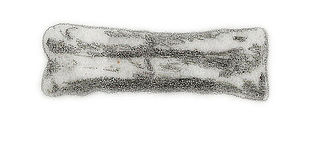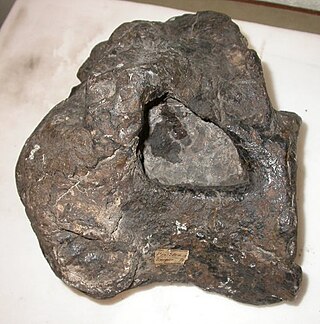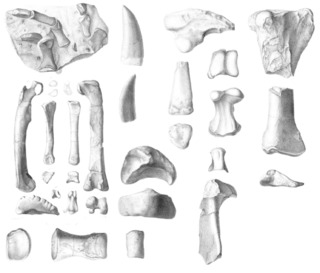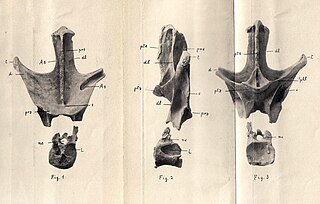
Megalosaurus is an extinct genus of large carnivorous theropod dinosaurs of the Middle Jurassic Epoch of southern England. Although fossils from other areas have been assigned to the genus, the only certain remains of Megalosaurus come from Oxfordshire and date to the late Middle Jurassic.

Antarctosaurus is a genus of titanosaurian sauropod dinosaur from the Late Cretaceous Period of what is now South America. The type species, Antarctosaurus wichmannianus, and a second species, Antarctosaurus giganteus, were described by prolific German paleontologist Friedrich von Huene in 1929. Three additional species of Antarctosaurus have been named since then but later studies have considered them dubious or unlikely to pertain to the genus.

Apatodon is a dubious genus of dinosaur that may have been a theropod. The type, and only species, A. mirus, was named in 1877 by Othniel Charles Marsh. It was found in the Late Jurassic-aged Morrison Formation of Colorado.

Altispinax is a genus of large predatory theropod dinosaur from the Early Cretaceous period of what is now the Wadhurst Clay Formation of East Sussex, England.

Teinurosaurus is a genus of carnivorous theropod dinosaur. Teinurosaurus lived during the Late Jurassic in what is now France. The type species is Teinurosaurus sauvagei. It's been estimated to be 11.4 m (37.4 ft) in length and 3.6 tonnes in weight.

Laplatasaurus is a genus of titanosaurian sauropod dinosaur that lived during the Late Cretaceous in South America, with the holotype and only known specimen found in the Anacleto Formation.

Magnosaurus was a genus of theropod dinosaur from the Middle Jurassic of England. It is based on fragmentary remains and has often been confused with or included in Megalosaurus.

Ornithopsis is a genus of sauropod dinosaur, from the Early Cretaceous of England and possibly Germany. The type species, which is the only species seen as valid today, is O. hulkei, which is only known from fragmentary remains.
Halticosaurus (pron.:"HAL-tick-oh-SORE-us") is a dubious genus of theropod dinosaur from the late Triassic period. It is known from a single fragmentary fossil specimen of the species H. longotarsus, found in the Middle Stubensandstein formation of what is present-day Germany The only known specimen was poorly preserved and may have been put together from bones of unrelated animals. Further research would be required to determine which of the bones belonged together, and what kind of theropod Halticosaurus was. However, most of the bones have been lost. For these reasons, Halticosaurus is considered to be a nomen dubium.
Clasmodosaurus is a genus of titanosaurian sauropod dinosaur from the Mata Amarilla Formation and the Cerro Fortaleza Formation. It lived during the Late Cretaceous in what is now Argentina. It is known from five fossilized and assorted teeth, but is diagnosed by a unique combination of characters.

Efraasia is a genus of basal sauropodomorph dinosaur. It was a herbivore which lived during the middle Norian stage of the Late Triassic, around 210 million years ago, in what is now Germany. It was named in 1973 after Eberhard Fraas, who during the early twentieth century collected what were the original type specimens.
Loncosaurus is an extinct genus of ornithopod dinosaur from the Upper Cretaceous of Provincia de Santa Cruz, Argentina. The type species is Loncosaurus argentinus, described by the famous Argentinian paleontologist Florentino Ameghino, but is considered a dubious name. Details on this animal are often contradictory, befitting a genus that was long confused for a theropod.

Erectopus is an extinct genus of basal allosauroid theropod from the Early Cretaceous La Penthiève Beds Formation of France and also possibly the Cernavodă Formation of southern Romania. The type species is E. superbus, which was initially known as a species of Megalosaurus.

Palaeosaurus is a genus of indeterminate archosaur known from two teeth found in the Bromsgrove Sandstone Formation and also either the Magnesian Conglomerate or the Avon Fissure Fill of Clifton, Bristol, England. It has had a convoluted taxonomic history.
Rileyasuchus is a genus of phytosaur from the Rhaetian Magnesian Conglomerate of England. It has a confusing history, being associated with the taxonomy of Palaeosaurus and Thecodontosaurus, and being a replacement name for a preoccupied genus.

Macrurosaurus is the name given to a genus of dinosaur from the Early Cretaceous. It was a titanosauriform which lived in what is now England. The type species, M. semnus, was named in 1876. A second species, M. platypus, may also exist.

Nopcsaspondylus is a genus of rebbachisaurid sauropod dinosaur from the Cenomanian-age Candeleros Formation of Neuquén, Argentina. It is based on a now-lost back vertebra described by Nopcsa in 1902 but not named at the time. The specimen had a small vertebral body and large hollows, now known to be typical of rebbachisaurids.
Rauisuchus is a genus of extinct archosaurs which lived in what is now the Geopark of Paleorrota, Brazil, during the Late Triassic period. It contains one species, R. tiradentes.
"Megalosaurus" dunkeri is a dubious species of theropod dinosaur, known only from a single tooth.
Amanzia is a genus of turiasaurian sauropod dinosaur from the Reuchenette Formation in Moutier, Switzerland. The type and only species is Amanzia greppini, originally named as a species of Ornithopsis and Cetiosauriscus.

























